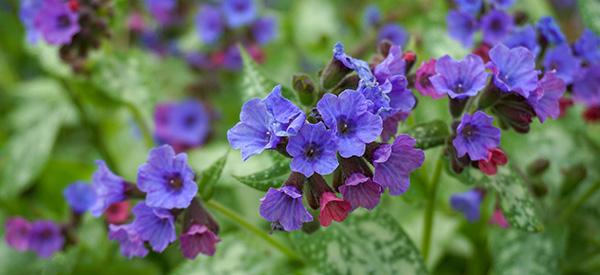
Lungwort
Lungwort (Pulmonaria officinalis) is an interesting herbaceous plant that looks prettier than it sounds. This two-toned flower changes its color from the pink into rose-red, violet, and blue as it matures. Its transformation gives it an appearance of gradience as it displays the color all at the same time. The unusually dotted leaves give lungwort its fascinating look. Mass planting lungwort can add a stark accent to a garden as it blooms in spring. They are best for border planting in patios, ponds, rock gardens, and shade gardens for their ornamental value.
Aesthetics aside, lungwort is also ideal in edible gardens. It is useful for both culinary and medicinal purposes. Lungwort leaves can be consumed raw or cooked and go well in salad and potherb. Its ayurvedic benefit is effective in the treatment of lung and pulmonary concerns.
Since the beginning of the 16th century, lungwort is already a common plant in many gardens. But, its history is older than its popularity. The plant is native to Europe and Eurasia, and it was used as an herb for treating the Bubonic plague in the 1300s. It became widespread in England for treating asthma and bronchial concerns. Lungwort was called the “Herb of Mary,” and according to folklore, it has the ability to reveal whether the person is a witch or not.
Where Lungwort Is Found
Lungwort is widespread throughout Europe and parts of Asia. It thrives in Ardennes, Netherlands, Denmark, and the South of Sweden. It is also found in northern to central Italy and reached Russia and the Caucasus. They can grow in coastal regions, piedmont, and mountains, preferring the high altitude. Lungwort can be seen in forest edges and even in disturbed habitats.
⇒ The Complete Map of Edible Plants: Find Out What You Have in Your Area! (Video)
How To Identify Lungwort
Lungwort is an understory species growing from mixed forests to low-lying mountains in shady areas. It has flowers that open at different times, displaying different colored tones as it blooms. The morphology of its flower is due to the changing pH level within the plant.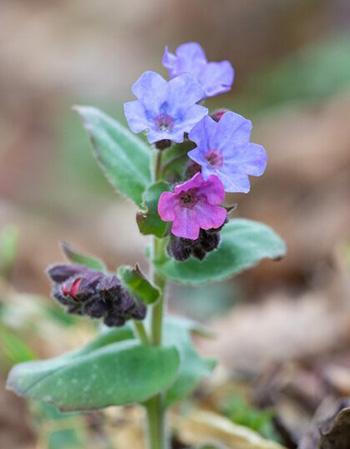
- Leaves. Lungwort leaves are oval in shape with a whole margin that resembles slightly that of lungs. The basal leaves are often elongated and pointed. Lungwort leaves have different shades of green and are covered with whitish spots. They are hairy and arranged alternately on the stem.
- Flowers. Differently-colored flowers appear in lungwort plants during spring. They are small, funnel-shaped, with five petals that appear in small bunches. Lungwort flowers often start out as pink as they are young. As they age, the anthocyanins change and change the color to red, purple, and blue. The plant then bears different colored flowers at the same time.
- Fruits and Seeds. After pollination, lungwort produces an egg-shaped nutlet that contains four shiny dark brown seeds.
- Roots. Lungwort has a rhizomatous root system. It has a slow-creeping rhizome and adventitious roots and is considered slightly invasive.
- Stem. The lungwort plant is upright and unbranched. The stem is roughly circular with lots of small angles and covered with downy hairs. It can grow up to 12 inches in height.
⇒ Plant Identification Guide – 400 Wild Plants That You Can Forage For (Video)
Pulmonaria officinalis is a specie that belongs to the Boraginaceae family. It is a perennial wildflower with the Latin name Pulmo, which means lungs, after its medicinal property and resemblance to a body part. This is taken from the concept of the Doctrine of Signatures. It states that the herbs that resemble a body part can treat the ailments of the particular body part.
Lungwort is also known as Jerusalem Cowslip, Jerusalem Sage, Mary’s Tears, and Our Lady’s Milk Drop. It is also called Soldiers and Sailors because its red and blue flowers are similar to the color of the uniform of the British army.
In the United States, lungwort has many introduced varieties such as:
- Benediction lungwort
- Excalibur lungwort
- Opal lungwort
- Red lungwort
- Sissinghurst White
How To Grow Lungwort
Lungwort is a polycarpic perennial, where it can produce clonally through its woody rhizomes. The rhizomes often form daughter rosettes near the mother plant. They may also grow from seeds, although the growth may be slower than root propagation.
There are many varieties of lungwort available in most online stores. Some of it can have lower quality than the lungwort seedlings or division you can find in the local nursery. However, if a parent plant is not available, growing lungwort from seeds is still a viable option.
Growing Lungwort from Seeds
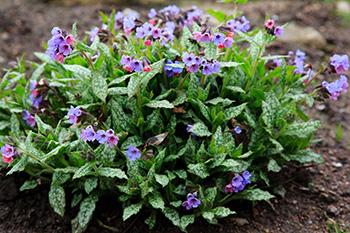 The best time for sowing lungwort seeds is in spring after the danger of the last frost. You can sow the seeds directly in the ground or grow them in potting mixes. Plant them in humus-rich and well-draining woodland soil. You can mix compost or peat humus to loosen the soil and keep it airy.
The best time for sowing lungwort seeds is in spring after the danger of the last frost. You can sow the seeds directly in the ground or grow them in potting mixes. Plant them in humus-rich and well-draining woodland soil. You can mix compost or peat humus to loosen the soil and keep it airy.
Sow the lungwort seeds and lightly cover them with soil. Keep the soil moist until seeds germinate and seedlings begin to emerge by 4 to 7 weeks. Lungwort germinates faster when kept at a temperature between 15 t0 17⁰C.
Transplant the seedlings in the garden about 15 cm apart. Or, you may plant them in a deep container that can accommodate their rhizomes. Water the plant regularly and mulch it in spring and summer.
Growing Lungwort from Rootstock Cuttings
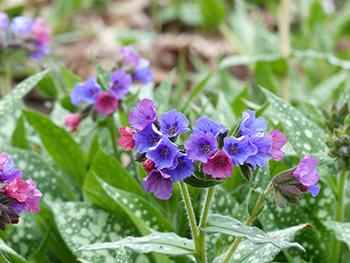 Propagating lungwort by division in fall, or right after the flowering stage of the parent plant, will yield a better result. Dig up the entire plant and divide it into sections with a sharp knife.
Propagating lungwort by division in fall, or right after the flowering stage of the parent plant, will yield a better result. Dig up the entire plant and divide it into sections with a sharp knife.
Propagate your lungwort by taking 2 to 3-inch long of its root cuttings with a crown. Plant it vertically into the soil with the crown side up.
Do not tamp the soil but cover it lightly, keeping it loose and airy.
⇒ 10 Plants That You Should Never Plant Together (Video)
Plant Care and Maintenance
Lungwort does not require extensive maintenance except regular watering during periods of dry spells. They grow best in partial shade with moist and well-draining soil rich in organic matter.
Generally, the plant is pest and disease-free. There may be rare cases of powdery mildew and slug infestation that are caused by a non-conducive soil medium with poor air circulation.
While they are relatively easy to care for, it is important to note that lungwort only thrives in a moist medium. They will wilt in dry soil and may die in wet areas and may invite pests and develop diseases.
The growing requirements for lungwort are: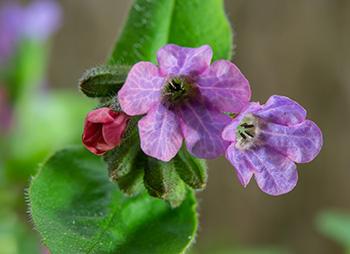
- Partial shade
- A moist and well-draining soil
- Even supply of water during the growing season
- Watering every 7 to 10 days during summer
- Pruning after the flowering stage
How To Harvest Lungwort
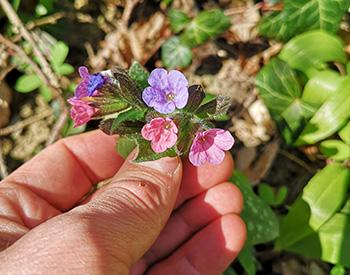 The leaves of the lungwort plant are edible and are harvested for their medicinal value. Its flowers are also used in some infusions and teas.
The leaves of the lungwort plant are edible and are harvested for their medicinal value. Its flowers are also used in some infusions and teas.
Harvest the aerial parts of lungwort in spring until April when its medicinal property is very potent. Simply cut the plant’s stem close to the ground with its leaves and flowers intact.
Tie the harvest in bunches and hang them by the stems in a shady and cool area.
Lungwort is used either as a whole dried plant or tincture for treating many diseases.
What Lungwort Is Good For And Natural Remedies Made From It
Some herbalists prescribe lungwort for a variety of respiratory problems and diarrhea.
Since the Middle Ages, people have been taking lungwort to treat cough and various respiratory symptoms. It is called lungwort not just as a reference to its leaves’ resemblance to the lungs, but it is also primarily due to its effectiveness in treating respiratory disorders. Although it still lacks the scientific evidence to further assess its efficacy, lungwort has already established itself in conventional medicine.
Lungwort is mucilaginous and its biologically active property has a beneficial effect on both internal and external inflammation. The mucilage protects the lungs and cavities against bacteria. This protective film also relieves irritation of the mucous membrane. It makes the lungwort more reliable in treating tuberculosis and bleeding of the lungs.
For smokers, taking lungwort can effectively remove the tar and expel it from the lungs. Its antibacterial property gets rid of bacteria and viruses from attacking the respiratory system.
The mucilage is not only beneficial for lung problems but also for the digestive system. It is used to treat digestive troubles like indigestion, constipation, stomach pain, and dyspepsia. Lungwort can also relieve diarrhea and other gastrointestinal complaints. It has a mild diuretic property which can reduce bloating due to excess water buildup.
Lungwort has ongoing research to prove its effectiveness in treating urinary tract infections. Owe it to the diuretic effect that promotes the production of fluid and increases the frequency of urination. Accordingly, it may help cure urinary tract infections and cystitis while expelling toxins and relieving the infection.
A tincture of lungwort applied externally treats eczema, hemorrhoids, burns, and wounds. It is a good source of antioxidants that, when taken internally can bring back benefits for the skin. It can heal wound tissues to expedite healing in wounds.
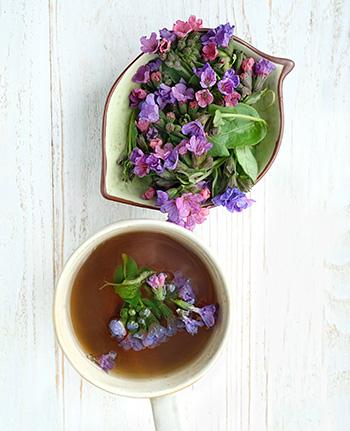
Lungwort is a homeopathic remedy for the treatment of:
- Pulmonary and other bronchial conditions and breathing issues
- Digestive complaints
- Sore throat
- Bleeding
- Urinary tract infections and other kidney problems
- Skin problems
- Eyewash for tired eyes
- Hemorrhoids
- Palpitation and agitation
⇒ Lungwort is a fascinating lichen in its own right. You can find lungwort lichen in the Bronchial Blend Tincture which also includes mullein for outstanding respiratory support. Visit the Apothecary today and give it a try!
What Parts Of The Lungwort Are Used For Remedies?
All the aerial parts of the plants are used in preparing oral and topical medicine. Its leaves are packed with benefits due to their high concentration of tannins, saponins, mucilage, silica, and flavonoids. Fresh lungwort leaves are astringent and are used to staunch bleeding.
Lungwort leaves are prepared as an infusion, tea, liquid extract, or tincture.
Lungwort comes in different forms such as fresh and dried leaves, tincture, syrup, tea, and capsules.
The flower of the lungwort can be made into a calming flower essence.
The usual oral dosage of lungwort in traditional medicine is 2 to 4 grams of dried leaves, 3 times a day. But lungwort supplements are not yet established. Its dosage still depends on the patient’s age, health, and other conditions.
⇒ I Stopped Spending Money At The Pharmacy By Growing These 10 Plants (Video)
Homemade Non-Alcoholic Lungwort Tincture
Ingredients:
- 25 grams/ 0.8 oz. dried lungwort leaves
- 125 mL/ 4.2 oz.organic apple cider vinegar
Steps:
- Place the dried leaves in the glass container and pour in the vinegar in a 1:5 herb to liquid ratio. Alternatively, you can use 80-proof vodka.

- Put a paper parchment between the container and the lid to prevent corrosion of the metal due to the acidic nature of the vinegar.

- Seal the glass and keep it close for 2 to 4 weeks. Shake the container daily until it is ready for straining.

- Strain the lungwort tincture into clean and dry tincture containers. Keep it capped until ready for use at a temperature below 25⁰C/77F. The mucilage in lungwort leaves makes it prone to spoiling.
How to use this remedy:
Lungwort tincture is taken for stomach and respiratory problems. Consult a herbalist for the recommended dosage after assessment of the ailment.
What Plants Resemble Lungwort
| Features | Lungwort (Pulmonaria officinalis) | Comfrey (Symphytum officinale) | Borage (Borago officinalis) |
|---|---|---|---|
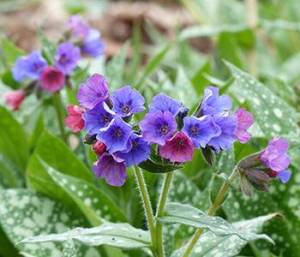 | 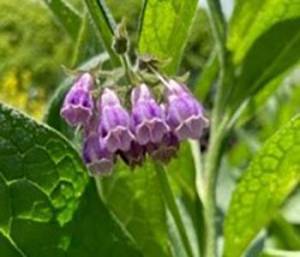 |  | |
| Size | Up to 30 cm tall | 30 to 90 cm | 30 to 90 cm |
| Leaves | Cordate to ovate; semi-evergreen; green with white specks; simple; alternate; hairy | Green; rough; lance to oval; simple; hairy | Edible; wrinkled; ovate; with bristly hairs |
| Flowers | Morphing colors from pink, red, purple, and blue; showy; funnel-shaped | Showy; pink/ purple/ white; funnel-shaped | Showy; blue; cyme; star-shaped |
| Fruits/Seeds | Egg-shaped nutlet; brown and shiny seeds | Small and dark nuts | Dark brown fruit; large black seeds |
| Stem | Upright; unbranched; hairy | Hairy; winged; green | Erect; vertically-grooved; hollow; hairy |
| Scent | No distinctive aroma | Foul smell | Cucumber-like scent |
Warnings and Cautions
Lungwort is not recommended for pregnant and breastfeeding women without substantial and reliable evidence for its safety.
You should also avoid taking lungwort as medicine if you are currently taking any medication or herbal supplement. Its interaction with other drugs is unknown, but it is best to stay on the safe side and avoid taking lungwort with any medications.
Dosing of lungwort also depends on the health and age of the user. It is advisable to consult a herbalist or a healthcare professional for the proper dosage.
When taking any herbal medication, always seek the advice of a physician to avoid harmful side effects.
You may also like:
 10 Herbs That Kill Viruses and Clear Lungs
10 Herbs That Kill Viruses and Clear Lungs
A Simple “At-Home” Protocol for the Flu and Other Respiratory Issues (Video)
How to Treat an Asthma Attack Naturally When You Don’t Have an Inhaler


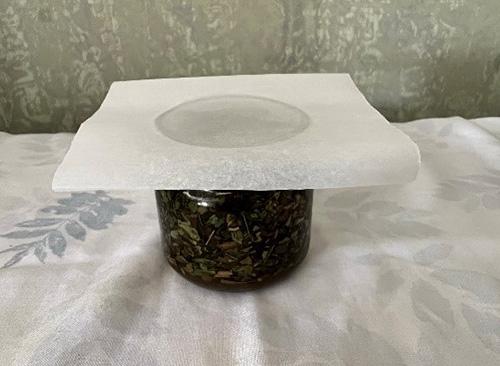
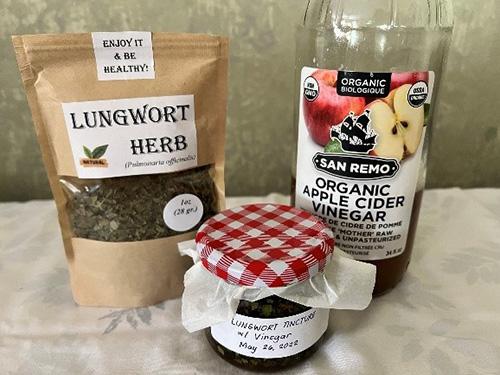
Can you list sources of lungwort herb for home use?
At the end of the section: ‘What Lungwort is Good for and Natural Remedies Made from it” there is mention of Lungwort Lichen. So, do Lungwort flower/herb and Lungwort Lichen both have the same medicinal qualities??
Susan, I am a 75-year- old cacasian and have bronchiectasis lung disorder. I use an inhaler (Flovent Diskus) twice a day, to help prevent lung infection. Might Lungwort be beneficial and safe, for me to use, in any manner? BTW, I bought your book and find it very interesting. I also read your caution about using other medications.
Sorry, I meant to address my question to Nicole Apelian, not Susan.
Can Lungwort grow in Zone-4?
Hi Terri,
Lungwort is hardy in zones 3 – 9.
Lungwort plants thrive in mild temperatures and tend to struggle in hot climates. They start growing as soon as the frost has passed in the spring. Hot summer weather might cause them to wilt; however, they should perk up again once the cooler temperatures of fall arrive.
Many blessings and good health!
Wonderful, thank you! I’ll look at my local nursery for the plant and hopefully find it.
Yes! Grows very well in zone 4 and is a beautiful perennial!
I love these kinds of posts. Do you sell a book with this kind of information in it?
Hi Kathy,
Thank you for your interest in our work.
Our books are available for purchase here:
https://thelostherbs.com/store/
Many blessings and good health!